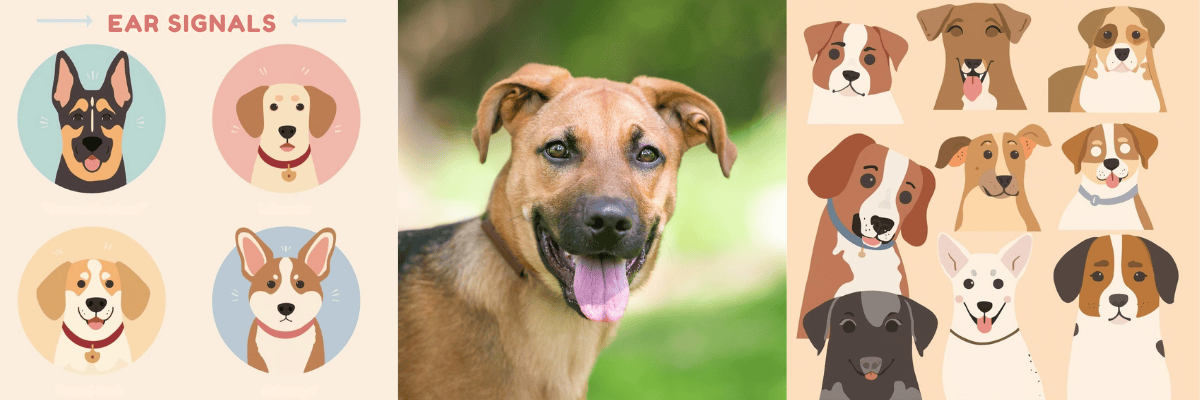Introduction
A dog’s ears can reveal more about their emotions than you might realize. From excitement and curiosity to fear and stress, the position and movement of your dog’s ears are powerful indicators of what they’re feeling. While many dog owners focus on tail wagging or facial expressions, ear signals provide subtle but important clues about your dog’s mood and intentions. In this post, we’ll guide you through the different ear positions and movements, explain what they mean in various contexts, and show you how to respond appropriately. By learning to read your dog’s ears, you’ll strengthen your communication, build trust, and deepen your bond with your furry companion.
Understanding the Importance of Dog Ears in Communication
A dog’s ears are more than just sensory organs—they are vital tools for communication. Dogs use their ears, along with their eyes, tail, and body posture, to express emotions and intentions. By paying attention to ear positions and movements, you can gain insight into your dog’s mood, alertness, and comfort level.

Ear Types and Their Influence on Signals:
- Upright Ears: Often seen in breeds like German Shepherds or Huskies; can make it easier to interpret alertness and focus.
- Floppy Ears: Common in breeds like Labradors or Beagles; movements may be subtler, so owners need to observe closely.
- Semi-Erect or Mixed Ears: May show a range of expressions, combining signals of curiosity, attentiveness, or relaxation.
Ears rarely act alone—they complement other cues. For example, forward ears with a wagging tail often indicate curiosity or excitement, while pinned-back ears combined with a tucked tail can signal fear or submission. Understanding how ears work in conjunction with other body language helps you interpret your dog’s emotional state accurately and respond appropriately.
Common Ear Positions and Their Meanings
Dogs communicate a lot through their ear positions. By learning to read these signals, you can better understand your dog’s emotions and intentions.

- Ears Up and Forward: Indicates alertness, curiosity, or focus. Your dog is paying attention to something interesting or new in their environment.
- Ears Relaxed or Neutral: Shows calmness and contentment. A dog with relaxed ears is comfortable and at ease.
- Ears Back or Flattened: Can signal fear, anxiety, submission, or appeasement. It’s a warning to approach gently or give them space.
- Ears to the Side or Swiveled: Often used when listening intently or assessing the surroundings. This position can indicate uncertainty or caution.
- One Ear Up, One Ear Down: May suggest mixed emotions or divided attention, showing curiosity while remaining cautious.
By observing these positions along with other cues, such as tail movement and facial expressions, you can interpret your dog’s feelings accurately and respond appropriately.
Ear Movements and Signals
In addition to ear positions, how your dog moves their ears can reveal important information about their emotional state. Paying attention to these subtle motions helps you understand what your dog is experiencing in the moment.
- Rapid Ear Flicks or Swivels: Often indicate heightened attention or excitement. Your dog is alert and actively processing sounds or movements around them.
- Slow Movement or Drooping: Can suggest relaxation, fatigue, or mild stress. Slow ear movements are often seen when a dog is winding down after play or adjusting to a calm environment.
- Pinned Ears Tightly Back: Signifies extreme fear, discomfort, or threat perception. This is a clear warning that the dog may be anxious or defensive.
- Combined Signals: Ear movements are most meaningful when read alongside other body language cues such as tail position, facial expressions, and overall posture. For example, ears pinned back with a tucked tail and lowered body indicate fear or submission, while ears forward with a wagging tail suggest curiosity and engagement.
By noticing these movements, you can respond to your dog’s needs promptly, whether it’s offering reassurance, giving them space, or engaging in playful interaction.
Reading Ears in Different Contexts
A dog’s ear signals can change depending on the situation. Understanding these contextual cues allows you to interpret their emotions more accurately.
- Playtime: During games, ears are often relaxed or slightly forward, showing excitement and engagement. Look for accompanying wagging tails and bouncy movements.
- Greeting People or Dogs: Forward ears and quick flicks indicate curiosity and interest. Your dog is attentive and ready to interact.
- Fearful Situations: Flattened ears, cowering posture, and a tucked tail signal that your dog feels threatened or anxious. Approach calmly or give them space.
- Aggression or Threat: Stiff body, forward ears, and direct staring indicate the dog is on high alert and may be ready to defend themselves. Avoid confrontation.
- Stressful Situations: Rapid ear flicking, pinned ears, or slight drooping can show nervousness or unease. Observing other signs like panting, yawning, or pacing helps confirm stress.
By analyzing ear signals in context, you can respond appropriately, ensuring both your dog’s comfort and your safety.
How to Respond Based on Ear Signals
Reading your dog’s ears is only helpful if you act appropriately based on what you observe. Here’s how to respond to different ear signals:

- Alert or Forward Ears: Your dog is curious or attentive. Engage them with play, training, or exploration to satisfy their interest.
- Relaxed or Neutral Ears: Indicates contentment. Continue calm interactions, petting, or bonding activities.
- Flattened or Pinned Ears: Shows fear or submission. Approach gently, offer reassurance, and avoid forcing contact. Give your dog space if needed.
- Stiff, Forward Ears with Other Warning Signs: May indicate aggression. Do not confront; step back, and ensure safety for both you and your dog. Professional guidance may be necessary for persistent aggression.
- Rapid Flicking or Mixed Signals: Assess the situation carefully. Your dog might be anxious, stressed, or excited. Observe other body cues to decide the best approach.
Responding appropriately to ear signals strengthens communication, builds trust, and helps prevent misunderstandings or conflicts.
Tips for Monitoring and Understanding Your Dog’s Ears
Consistent observation of your dog’s ears can give you valuable insight into their feelings and needs. Here are practical tips to help you interpret ear signals effectively:
- Observe During Daily Routines: Pay attention to how your dog holds and moves their ears during walks, playtime, feeding, and greetings. Patterns emerge over time.
- Combine with Other Body Language: Ear positions are most meaningful when considered alongside tail movement, facial expressions, and posture.
- Take Notes: Recording triggers and corresponding ear signals helps you understand your dog’s personality and reactions.
- Adjust Interactions: Respond to ear cues by providing reassurance, engagement, or space as needed. This ensures your dog feels safe and understood.
- Respect Individual Differences: Remember that ear signals can vary by breed and individual temperament. Some dogs may naturally hold ears differently, so context is key.
Monitoring ear signals regularly improves communication and helps prevent misunderstandings or stress.
Conclusion
A dog’s ears are a window into their emotions, revealing curiosity, excitement, fear, stress, or even aggression. By learning to read ear positions and movements in combination with other body language cues, you can understand your dog’s feelings more accurately and respond appropriately. Observing your dog’s ears during different situations—play, greetings, stressful moments, or interactions with other dogs—helps you build trust, improve communication, and strengthen your bond. Paying attention to these subtle signals ensures your dog feels heard, safe, and loved, creating a happier and more harmonious relationship for both of you.




Leave a Reply